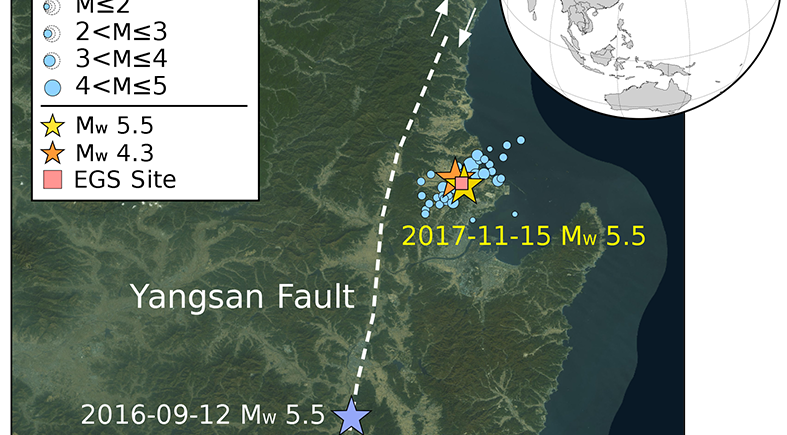On 15 November 2017 a strong earthquake with a magnitude of 5.5 struck the city of Pohang in South Korea. In a current study, a team of researchers investigates the nature of this event and if there may possibly be any connection between the earthquake and the geothermal site close by. This study, published in the journal Science has been co-authored by scientists from the Helmholtz Centre Potsdam, GFZ German Research Centre for Geosciences.
The geothermal project Pohang is an Enhanced Geothermal System (EGS) site where water is injected under high pressure via deep boreholes into the underground, also called “hydraulic stimulation”. The study concludes there may potentially be a correlation between the injection and the earthquake due to the close proximity. At the same time the authors stress that one year previously a similarly strong 5.4 earthquake occurred at a distance of 38 kilometers SSW of the drilling in a different geological fault. Thus, further research is needed to better understand any possible connections.
The current study combines seismological and geodetic analyses and found that the hypocenter of the 2017 earthquake lies in a geological fracture zone approximately one kilometer from the EGS site. The origin of the earthquake corresponds with a thrust-dominated complex rupture at a depth of 4.5 kilometers.
Torsten Dahm, Head of the GFZ Section Physics of Earthquakes and Volcanoes and co-author of the study explains: “Given its location, it is possible that the earthquake was influenced by human activities. In order to estimate the probability of the event to be human triggered we will, in a next step, combine hydromechanical modelling and physics-based triggering models.”
In what way human activity could have played a role is still unclear. In August 2017 scientists involved in the international DESTRESS project (Demonstration of soft stimulation treatments of geothermal reservoirs), carried out a so-called soft stimulation in Pohang. A special element hereby is that after weak seismic events the stimulation is stopped and followed by a complete flowback of the injected water. “This technology was developed within the framework of DESTRESS in order to avoid larger seismic events. The efficacy in comparison to other conventional stimulations was shown in Pohang,” says Ernst Huenges, Head of the GFZ Section Geothermal Energy Systems and leader of the international DESTRESS project, but not, however, involved in the current study in Science. “Our stimulation, during which relatively little water was used did not lead to any seismic activity larger than magnitude 2.0. This value, however, was clearly exceeded by the conventionally executed stimulations that were not carried out within the framework of DESTRESS. The last conventional stimulation carried out by the commercial plant operator ended on 18 September 2017, two months before the Pohang earthquake.”
Unlike the Science publication, scientists within the DESTRESS project distinguish, in the case of seismic events attributed to human activity, between "induced" and "triggered". Triggered are those events in which a relatively small intervention leads to a fracture in an already stressed geological fault, similar to the proverbial “drop” that causes a barrel to overflow. Induced, on the other hand, are those events where the applied energy alone causes the stimulation of the earthquake. Thus “induced” in this sense can be ruled out for the Pohang event. “For the DESTRESS consortium, too, the urgent question on a possible connection between the geothermal site and the earthquake of 15 November 2017 needs to be clarified,” adds Ernst Huenges. “That is why we are currently bringing together relevant geometric, hydraulic and seismic data in a European-Korean cooperation in order to develop a physically-based understanding of the processes. In this way a reliable basis for reliable risk assessment before future stimulation can be created.”
Original study: Grigoli, F., Cesca, S., Rinaldi, A.P., Manconi, A., López-Comino, J.A., Clinton, J.F., Westaway, R., Cauzzi, C., Dahm, T., Wiemer, S., 2018. The November 2017 Mw 5.5 Pohang earthquake: A possible case of induced seismicity in South Korea. Science . DOI: 10.1126/science.aat2010









![[Translate to English:] Torsten Sachs in front of a climate station on a field](/fileadmin/_processed_/3/9/csm__TorstenSachs_bearbeitet_GS_4a1365ef84.jpeg)

![[Translate to English:] left image flood at the Ahrtal: image from above, several houses are flooded; left image:: Heidi Kreibich;](/fileadmin/_processed_/4/4/csm_Bild2_9af0130e9f.png)



![[Translate to English:] Start der Vega Rakete](/fileadmin/_processed_/6/4/csm_20231201-kachel_Vega-VV23-launch_ESA-CNES-Arianespace_706716b68c.jpeg)









![[Translate to English:] Poster exhibition at the Brandenburg Hydrogen Day at the GFZ, some participants in the foreground](/fileadmin/_processed_/6/5/csm_Erster_Brandenburgischer_Wasserstofftag_GFZ_402fcec95e.jpeg)
![[Translate to English:] Group picture of the participants](/fileadmin/_processed_/9/4/csm_20231108_CAWa-Workshop-Tashkent_Gruppenbild_99ea779d8a.jpeg)

![[Translate to English:] [Translate to English:] Hörsaal](/fileadmin/_processed_/e/6/csm_H%C3%B6rsal_e21ac645fb.jpeg)


![[Translate to English:] The Delegations in the Historic Library on the Telegrafenberg. In the back there are from left to right, the Dutch Ambassador for Germany, Ronald van Roeden, the Dutch Minister for Education, Culture and Science, Robbert Dijkgraaf and the scientific director of the GFZ, Susanne Buiter.](/fileadmin/_processed_/d/b/csm_Kachel-2_9eba4b4212.jpeg)

